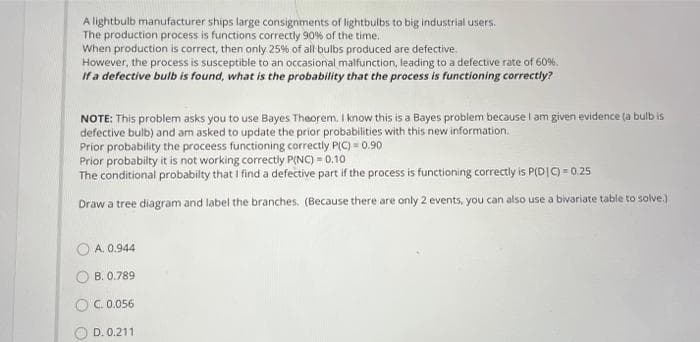A lightbulb manufacturer ships large consignments of lightbulbs to big industrial users. The production process is functions correctly 90% of the time. When production is correct, then only 25% of all bulbs produced are defective. However, the process is susceptible to an occasional malfunction, leading to a defective rate of 60%. If a defective bulb is found, what is the probability that the process is functioning correctly? NOTE: This problem asks you to use Bayes Theorem. I know this is a Bayes problem because I am given evidence (a bulb is defective bulb) and am asked to update the prior probabilities with this new information. Prior probability the proceess functioning correctly P(C) = 0.90 Prior probabilty it is not working correctly P(NC) = 0.10 The conditional probabilty that I find a defective part if the process is functioning correctly is P(DIC) = 0.25 Draw a tree diagram and label the branches. (Because there are only 2 events, you can also use a bivariate table to solve.) OA 0.944 B. 0.789
A lightbulb manufacturer ships large consignments of lightbulbs to big industrial users. The production process is functions correctly 90% of the time. When production is correct, then only 25% of all bulbs produced are defective. However, the process is susceptible to an occasional malfunction, leading to a defective rate of 60%. If a defective bulb is found, what is the probability that the process is functioning correctly? NOTE: This problem asks you to use Bayes Theorem. I know this is a Bayes problem because I am given evidence (a bulb is defective bulb) and am asked to update the prior probabilities with this new information. Prior probability the proceess functioning correctly P(C) = 0.90 Prior probabilty it is not working correctly P(NC) = 0.10 The conditional probabilty that I find a defective part if the process is functioning correctly is P(DIC) = 0.25 Draw a tree diagram and label the branches. (Because there are only 2 events, you can also use a bivariate table to solve.) OA 0.944 B. 0.789
Holt Mcdougal Larson Pre-algebra: Student Edition 2012
1st Edition
ISBN:9780547587776
Author:HOLT MCDOUGAL
Publisher:HOLT MCDOUGAL
Chapter11: Data Analysis And Probability
Section11.8: Probabilities Of Disjoint And Overlapping Events
Problem 2C
Related questions
Question
Hw.37.

Transcribed Image Text:A lightbulb manufacturer ships large consignments of lightbulbs to big industrial users.
The production process is functions correctly 90% of the time.
When production is correct, then only 25% of all bulbs produced are defective.
However, the process is susceptible to an occasional malfunction, leading to a defective rate of 60%.
If a defective bulb is found, what is the probability that the process is functioning correctly?
NOTE: This problem asks you to use Bayes Theorem. I know this is a Bayes problem because I am given evidence (a bulb is
defective bulb) and am asked to update the prior probabilities with this new information.
Prior probability the proceess functioning correctly P(C) = 0.90
Prior probabilty it is not working correctly P(NC) = 0.10
The conditional probabilty that I find a defective part if the process is functioning correctly is P(DIC) = 0.25
Draw a tree diagram and label the branches. (Because there are only 2 events, you can also use a bivariate table to solve.)
A. 0.944
B. 0.789
C. 0.056
D. 0.211
Expert Solution
This question has been solved!
Explore an expertly crafted, step-by-step solution for a thorough understanding of key concepts.
Step by step
Solved in 2 steps with 1 images

Recommended textbooks for you

Holt Mcdougal Larson Pre-algebra: Student Edition…
Algebra
ISBN:
9780547587776
Author:
HOLT MCDOUGAL
Publisher:
HOLT MCDOUGAL



Holt Mcdougal Larson Pre-algebra: Student Edition…
Algebra
ISBN:
9780547587776
Author:
HOLT MCDOUGAL
Publisher:
HOLT MCDOUGAL

